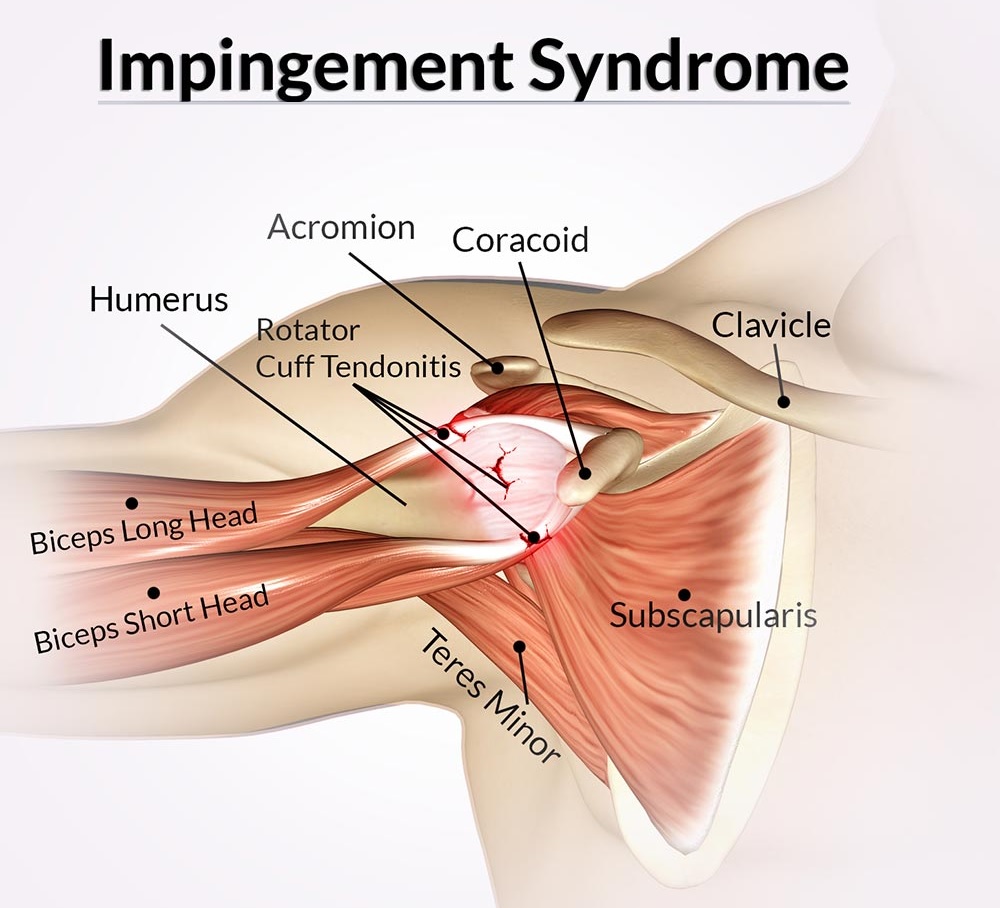Shoulder Impingement Syndrome at DRHC Dubai Shoulder Specialist Dubai
Dubai Shoulder Clinic at DRHC provides treatment for shoulder sports injuries on a daily basis and provides fully comprehensive service. To consult with the best shoulder specialist in Dubai, you can call +97142798200.
Impingements Syndrome of the Shoulder:
Shoulder impingement syndrome is the most frequent cause of shoulder pain in sports and the average population. The term impingement is used to describe the pain and inflammation (tendonitis in the shoulder) as a result of the frequent friction between the rotator cuff and the bony-ligamentous arch above the rotator cuff which is formed by the acromion and the Coraco- acromial ligament. This is what is called primary impingement syndrome.
Anatomy:
The rotator cuff is a compound of muscles and tendons that form a cover around the humeral head and connect it to the scapula. The function of the rotator cuff is to keep the shoulder joint in place and to help with the movement of the shoulder in abduction and external rotation.
There is a lubricating membrane which is called the Bursa which separates the rotator cuff from the acromion which is the bone on top of the rotator cuff allowing no direct contact.
Impingement syndrome pain can be related to either tendinitis of the rotator cuff bursitis or both. The tendinitis or Bursitis can arise as a result of excessive overhead activities or due to a bony spur from the anterior part of the acromion catching against the rotator cuff or the bursa, or as a result of an osteophyte from the acromioclavicular joint which can also cause the same.
Frequent impingement of the rotator cuff will lead gradually to a tear in the cuff which can be catastrophic in the long-term leading to progressive arthritis of the shoulder joint. Therefore we recommend adequate treatment of impingement syndrome at the early stages to prevent any long-term complications.

Symptoms and Diagnosis:
The patient describes pain in the anterior aspect of the shoulder and upper part of the arm, particularly with overhead activities. They also describe pain at night, weakness in shoulder function, and difficulties placing the arm behind the back, particularly ladies trying to deal with their bras.
The clinical examination will help to identify the source of the pain and the painful arc related to impingement syndrome and also to identify if there is any particular tear in the rotator cuff leading to weakness, particularly in external rotation movements.
The clinical examination is augmented by radiological investigation including a simple x-ray to identify the anatomical shape of the acromion and if there are any particular bony spurs causing the impingement and also to assess the acromioclavicular joint. Shoulder MRI scans have the advantage of identifying the integrity of the rotator cuff and also identifying the area of inflammation around the rotator cuff and the fluid retention in the bursa.
Treatment:
Most impingement syndrome cases are treated primarily with conservative management using non-steroidal anti-inflammatory medication and physiotherapy to increase the range of motion and muscle strength. Some cases may require a steroid injection in the subacromial space to deal with the significant inflammation. The patient is also advised to avoid excessive overhead activities during the treatment period to avoid any recurrence of his condition.
If the Conservative management fails, the surgeon would have to recommend surgical treatment in the form of arthroscopy of the shoulder to perform anterior acromioplasty to remove a piece of bone that is interfering with the rotator cuff. This is usually done with the help of the arthroscopic technique. During arthroscopy, the surgeon will remove the inflamed bursa and inspect the rotator cuff for any tear, which may require repair at the same time. The surgeon would also inspect the acromioclavicular joint and check if there is any particular impingement caused by the AC joint by a bony growth from the undersurface of the joint.
Most of the cases settle fully after the arthroscopic procedure which is usually followed by physiotherapy and a rehabilitation program. It takes approximately 6 to 8 weeks for most sports players to return to almost full activity after simple subacromial decompression particularly if no rotator cuff repair was carried out.
.png?width=281&height=59&name=bookanappointment%20(1).png)
Dubai Shoulder Clinic at DRHC provides shoulder arthroscopy, shoulder surgery, and treatment for shoulder pain, frozen shoulder, dislocated shoulder, shoulder impingement, and so on. Call +97142798200 to Schedule Your Appointment Today.





.png?width=281&height=59&name=bookanappointment%20(1).png)





